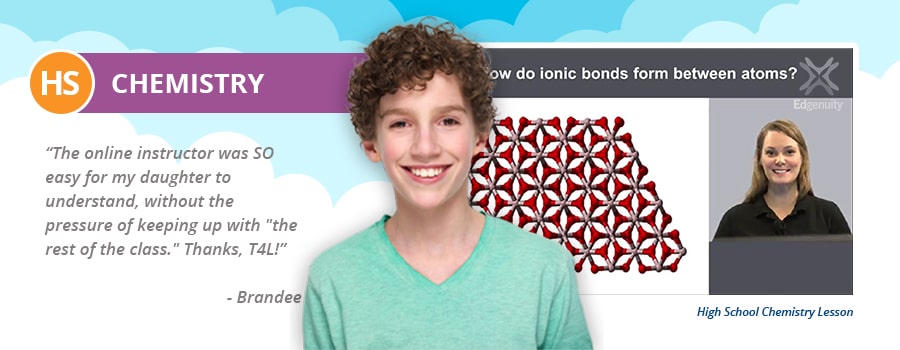High School Chemistry Curriculum
A chemistry curriculum will prepare your student to fully comprehend the composition and properties of matter, changes and interactions of matter, organic chemistry, nuclear chemistry and more.
Read on to learn more about Time4Learning’s high school chemistry curriculum and how it can help students better understand the world around them, as well as achieve their academic goals.
What Do You Teach in High School Chemistry?
High school chemistry introduces students to more complicated topics such as stoichiometry, thermodynamics, virtual laboratory experiments, and more. This strong base of knowledge will prepare them for subjects such as physics and advanced biology in the near future.
Some other topics that should be covered in tenth grade chemistry include:
- The difference between physical properties and chemical properties of matter.
- The relationship between the number of neutrons in an atom of an element, its mass number, and its isotopes.
- How hydrogen bonding and van der Waals forces affect the volatility, boiling points, and melting points of liquids and solids.
- How kinetic-molecular theory explains the properties of plasmas.
- Spontaneous and nonspontaneous reactions.
- The Bronsted-Lowry definitions of acids and bases.
- The role of nuclear fusion to the production of essentially all elements heavier than helium.
Learning Objectives for Chemistry
By the end of the course, students should have a working understanding of the basic concepts of chemistry including atomic numbers and electron configurations, the ideal gas law, enthalpy and phase changes, and more.
Learning objectives for high school chemistry typically include:
- Describe heterogeneous mixtures, including suspensions and colloids.
- Use the periodic table to identify trends in electronegativity and electron affinity.
- Design and conduct an experiment to test the properties of substances.
- Write equilibrium expressions, and use them to calculate the equilibrium constant for reactions.
- Interpret the behavior of ideal gases in terms of kinetic-molecular theory, including diffusion and effusion.
- Describe how to measure pH with indicators and meters.
- Explain and compare fission and fusion reactions.
- Identify which household chemicals are dangerous to keep together or mix.
Why Choose Time4Learning’s Chemistry Homeschool Curriculum
Time4Learning’s homeschool chemistry curriculum covers the basic concepts of chemistry and includes virtual laboratory experiments that encourage higher-order thinking applications. Students must be comfortable with algebra to understand and work chemistry problems. This is one of the reasons why we recommend chemistry at the 10th grade level. However, parents can choose whichever science course they prefer.
Our chemistry curriculum for high school not only teaches the concepts of chemistry, but also the vocabulary, the elements and chemical equations to help students interpret chemistry.
Here are some additional benefits Time4Learning provides parents and teachers.
As a Full Curriculum
|
As a Supplement
|






